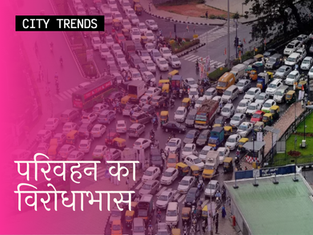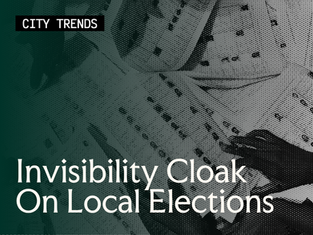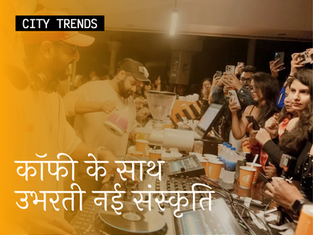top of page


Urban Flooding Crisis in Small Cities
India’s smaller cities face a growing urban flooding crisis driven by outdated drainage systems, unmanaged solid waste, and blocked natural waterways. Frequent waterlogging occurs due to clogged open drains, unchecked waste management, and inadequate pre-monsoon desilting. Some of our smaller cities regularly experience flooding even during moderate rains. Judicial interventions and local innovations, such as trash barriers and river clean-ups, show promise. However, sustaine
Sep 24, 20257 min read


Parking: A Multi-Level Issue
In India’s small and mid-sized cities, multi-level car parking (MLCP) projects are increasingly promoted to address growing parking pressures. Yet, most facilities remain underutilised, often lying vacant despite significant investment. This article examines the reasons behind this paradox, including behavioural preferences for on-street parking, accessibility challenges, safety concerns, and inadequate integration with broader urban mobility strategies. It explores how succe
Sep 2, 20257 min read


Stray Realities
The recent Supreme Court ruling directing the capture and sheltering of stray dogs in Delhi-NCR has pushed the issue into sharp national focus. This article explores how such orders clash with existing laws and collide with the fragile realities of city governments already struggling with funds, staff, and facilities. Drawing on local and global lessons, the article argues that humane and effective stray dog management will require a shared approach, where courts, municipalit
Aug 20, 20257 min read


Who Owns Civic Sense Beyond Individual Blame?
In India’s small and mid-sized cities, civic behaviour is often framed as a question of personal morality but what if the story is more complex? This commentary examines how systemic gaps, weak enforcement, cultural conditioning, and the pressures of daily survival shape public conduct. Moving beyond the rhetoric of “zero civic sense,” it asks who truly bears responsibility for maintaining civic order, is it the individuals, institutions, or the collective and what it would t
Jul 23, 202511 min read


Disparities From Source To Structure
As summer intensifies, India’s smaller cities face an escalating water crisis, where turning on a tap often means uncertainty. Despite national initiatives like AMRUT 2.0 promising improved access, local challenges—aging infrastructure, stalled projects, and uneven supply—persist. While some cities innovate with smart meters, others remain stuck in outdated systems. Can these ambitious plans truly bridge the gap between infrastructure and water justice?
May 1, 202514 min read


पानी की असमानता: स्रोत से सप्लाई तक
गर्मियाँ बढ़ने के साथ, भारत के छोटे शहरों में पानी की किल्लत और बढ़ रही है, जहाँ नल खोलना अक्सर अनिश्चितता लेकर आता है की पानी आया की नहीं । AMRUT 2.0 जैसे राष्ट्रीय कार्यक्रम बेहतर पानी पहुँचाने का वादा करते हैं, लेकिन यहाँ की पुरानी पाइपलाइन, अधूरे प्रोजेक्ट और अनियमित सप्लाई जैसी समस्याएँ बनी हुई हैं। कुछ शहर स्मार्ट मीटर से नवाचार कर रहे हैं, तो कई पुराने सिस्टम में फंसे हैं। क्या ये बड़े प्लान सच में बुनियादी ढांचे और पानी की न्याय के बीच की दूरी पाट पाएंगे?
May 1, 202519 min read


Needles In The Haystack
The rules for biomedical waste disposal are clear. The guidelines exist, the penalties are defined, and the responsibility is assigned. Yet, in India’s small cities, biomedical waste continues to find its way into drains, water bodies, open fields, and garbage dumps. Why does this happen? Why do small cities struggle to manage their medical waste safely?
Mar 6, 20259 min read


मेडिकल कचरे की अनदेखी कहानी
बायोमेडिकल कचरा निपटाने के नियम तो स्पष्ट हैं। दिशा-निर्देश मौजूद हैं, जुर्माने तय हैं, और जिम्मेदारी भी तय की गई है। फिर भी, भारत के छोटे शहरों में बायोमेडिकल कचरा नालों, जल स्रोतों, खुले मैदानों और कूड़ेदानों में मिलता रहता है। ऐसा क्यों होता है? छोटे शहर अपने मेडिकल कचरे को सुरक्षित तरीके से प्रबंधित करने में क्यों असमर्थ हैं?
Mar 6, 202512 min read


Are Small Cities Planning for Cars or People?
In India’s smaller cities, cars get the spotlight while pedestrians and cyclists fight for space. There exists glaring contradictions in India's urban mobility: from footpaths turned parking lots to sidelined e-rickshaws, despite most people relying on walking, cycling, or informal transport! As cities chase costly metro dreams, are we overlooking the modes that truly keep them moving?
Feb 19, 20258 min read


परिवहन का विरोधाभास
भारत के छोटे शहरों में गाड़ियों को खास तवज्जो मिलती है, जबकि पैदल चलने वालों और साइकिल चालकों को जगह के लिए संघर्ष करना पड़ता है। हमारे शहरी परिवहन में कई साफ-साफ विरोधाभास दिखते हैं — फुटपाथों को पार्किंग में बदल दिया गया है, ई-रिक्शा जैसे साधनों को नजरअंदाज किया जाता है, जबकि ज़्यादातर लोग चलकर, साइकिल से या अनौपचारिक साधनों से ही सफर करते हैं। शहर महंगे मेट्रो प्रोजेक्ट्स के पीछे भाग रहे हैं, लेकिन क्या हम उन साधनों को नजरअंदाज़ कर रहे हैं जो सच में शहरों को चलाते हैं?
Feb 19, 202510 min read


स्थानीय चुनावों पर अदृश्यता की चादर
जिस लोकतंत्र की बुनियाद जनता के वोटों पर टिकी हो, वहां शहर स्तर के चुनाव इतने अदृश्य क्यों हैं? कभी वोटर लिस्ट में नाम ही नहीं होता, तो कभी घोषणापत्रों में सिर्फ़ झूठे और धुंधले वादे होते हैं। नगर निकाय चुनाव अक्सर बिना चर्चा या ध्यान के निकल जाते हैं — जबकि असल में वही हमारे रोज़मर्रा के जीवन को आकार देते हैं। इस चुपचाप चल रही गड़बड़ी और जवाबदेही की धुंधली तस्वीर के बीच शायद अब वक्त आ गया है कि नागरिक सवाल पूछें: हमारे शहरों को असल में चला कौन रहा है?
Feb 5, 20258 min read


Why Municipal Polls Matter More Than We Think?
In a democracy built on the votes of the masses, why do city-level elections remain so invisible? From missing voter names to vague claims in manifestos, municipal polls often slip by unnoticed, even as they shape our everyday lives. Amidst the quiet dysfunction of local elections and blurred lines of accountability, perhaps it’s time citizens start asking: who really governs our cities?
Feb 5, 20256 min read


परंपराएं, रिमिक्सड - 2025 एडिशन
2025 के करीब आते ही, भारत के छोटे शहरों में न्यू इयर ईव की खुशियां अब परंपरा और ग्लोबल ट्रेंड दोनों को अपना रही हैं। जो कभी सिर्फ़ परिवारों के बीच सिमटा हुआ जश्न होता था, वह अब पूरे समुदाय की जीवंत महफिल बन गई है। इन उत्सवों के साथ-साथ स्थिरता और आध्यात्मिकता की ओर भी रुझान बढ़ा है, जहां नागरिक साफ-सुथरे और हरे-भरे शहरों की उम्मीद जताते हैं। जब परंपराएं नए अंदाज में पेश हो रही हैं, तो आपके शहर ने नए साल का स्वागत कैसे किया?
Jan 30, 20253 min read


Traditions, Remixed - 2025 ed.
With 2025 on the horizon, New Year's Eve celebrations across India’s small towns are embracing both tradition and global trends. What were once intimate family gatherings have transformed into lively community events. Alongside the festivities, there's also a shift towards sustainability and spirituality, with citizens voicing hopes for cleaner, greener cities. With the traditions remixed, how did your town welcome the new year?
Jan 30, 20252 min read


कॉफी के साथ उभरती नई संस्कृति
भारत की कॉफी संस्कृति में एक अद्भुत क्रांति आई है, जो अब केवल फ़िल्टर कॉफी के रीजनल शौक से निकलकर पूरे देश में फैले ट्रेंड में बदल गई है। आधुनिक कैफे संस्कृति तेजी से बढ़ रही है, जहां घरेलू और अंतरराष्ट्रीय ब्रांड अब टियर-2 और टियर-3 शहरों तक पहुंच रहे हैं। कॉफी की सांस्कृतिक जड़ें गहरी हैं। बदलती जीवनशैली, डिजिटल मीडिया का असर, और युवाओं में स्पेशलिटी कॉफी के प्रति बढ़ती रुचि की वजह से कॉफी अब सिर्फ एक पेय नहीं, बल्कि एक नया जीवनशैली का हिस्सा बन गई है।
Jan 22, 20255 min read


How has the Coffee Culture affected India's Smaller Cities?
India’s coffee culture has undergone a remarkable revolution, evolving from a regional passion for filter coffee to a nationwide trend. While the modern café scene is thriving with homegrown and global chains expanding into Tier-II and III cities, coffee’s cultural roots run deep. Driven by changing lifestyles, digital media influence, and the younger generation’s growing taste for specialty brews, coffee is now more than just a beverage; it’s a new lifestyle statement.
Jan 22, 20254 min read


पहचान के धागे
जब आप कांचीपुरम, फिरोज़ाबाद या खुर्जा का नाम सुनते हैं, तो सबसे पहले आपके मन में क्या आता है? शायद कांजीवरम साड़ियां, कांच की चूड़ियां या चीनी मिट्टी से बनी वस्तुएं (सिरेमिक)। पूरे भारत में छोटे, पुश्तैनी व्यवसाय और कुटीर उद्योग अपने शहरों के साथ इतनी गहराई से जुड़े हुए हैं कि दोनों को अलग करना काफी मुश्किल काम है। हैंडलूम और इसी तरह के क्षेत्रों के छोटे व्यवसाय सिर्फ़ आर्थिक इकाइयां नहीं हैं, बल्कि ये छोटे शहरों की आत्मा हैं।
Jan 8, 20254 min read


Signalling Storms
With heavy rainfall alerts rising in the Himalayas, fragile geographies, inadequate planning, and climate extremes are exposing deep vulnerabilities. Amid official efforts and emerging citizen initiatives, questions remain about whether hill towns are truly better prepared? Or are they still caught in a cycle of risk and recovery?
Jul 18, 20242 min read


छोटे शहरों में बढ़ती गर्मी
भारत के छोटे शहर रिकॉर्ड तोड़ गर्मी की लहर से जूझ रहे हैं, जैसे ऊटी, बाडमेर और रतलाम में अब तक के सबसे अधिक तापमान दर्ज किए गए हैं। अध्ययनों से पता चलता है कि शहरीकरण भी तापमान बढ़ने का एक बड़ा कारण है। ऐसे में ये शहर इन कठिन हालातों से कैसे निपट रहे हैं? हीट एक्शन प्लान, कूलिंग स्टेशन और समुदाय आधारित पहल जैसी नई रणनीतियां लागू की जा रही हैं। क्या ये कदम बढ़ती गर्मी की समस्या से लड़ने की चाबी साबित होंगे?
Jun 30, 20247 min read


The Urban Bazaar Conundrum
Across India, weekly haats have long been more than just markets; they are vital spaces of culture, trade, and community. From Kalimpong’s Bihibare Haat to Guwahati’s Beltola Bazaar, haats continue to evolve in urban settings, even as civic challenges arise. As cities rush to build curated versions like Dilli Haat, are there ways to preserve the organic spirit of traditional haats while adapting to urban realities?
Jun 28, 20245 min read
bottom of page